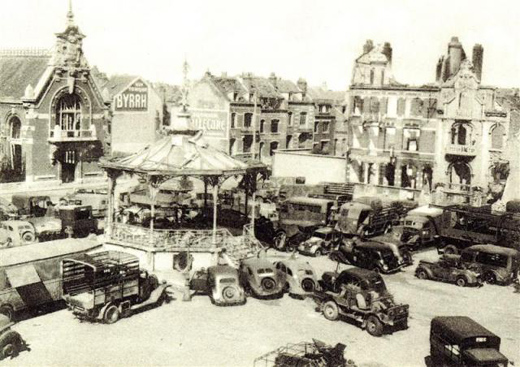Air Operations, Europe
The French government threatens reprisals for the Paris raid. During the night French bombers attack Munich and Frankfurt.
[Britain, Home Front
Britain is left practically unarmed. At the end of the Dunkirk evacuation there remain on British soil only 500 guns of all types, and some of these are museum pieces.
Churchill delivers perhaps the most famous of his great wartime speeches. His message is, 'We shall fight on the beaches...We shall never surrender'. Already he is talking of the time when '...The New World, with all its power and might, steps forth to the rescue and the liberation of the Old'. This message seems to suggest that France will be beaten, leaving Britain to fight alone. This is not perhaps the best way to encourage the French.
[Norway
The Allied evacuation gets under way. During the next few days the Harstad force is taken off. The total number evacuated is 24,500. The considerable base organization which has been built up has to be dismantled.
The battlecruisers Scharnhorst and Gneisenau leave Kiel with orders to intercept the Allied evacuation fleet from Norway.
[Western Front, Dunkirk
At 3:40a.m. the destroyer Shikari leaves Dunkirk, the last ship to evacuate French troops. At dawn the Germans enter Dunkirk and capture all the remaining French soldiers numbering about 40,000. Between May 27 and the early hours of June 4 338,226 of which 112,000 are French have been evacuated. Almost all heavy equipment has been lost and many of the troops are without rifles and basic kit. Against the original expectation that a maximum of perhaps 50,000 men might be taken off it has been something of a triumph, but at some cost. The British and French navies have lost at least 80 merchant craft and warships as well as many small vessels. 9 destroyers have been sunk. The operation was directed by the senior naval officer at Dover, Adm Sir Bertram Home Ramsay, who mobilized every available ship, including private yachts and fishing boats, big and small. In the course of this courageous and desperate rescue operation, some 200 ships were lost, as well as 177 aircraft (40 per cent of them bombers, against about 140 lost by the Luftwaffe. In accordance with the military principle that priority is given to men over arms and equipment, the British had to leave behind on French soil 2,472 guns, 84,627 vehicles, 76,000 tons of ammunition and 600,000 tons of fuel and supplies.
Abandoned Vehicles in Dunkirk |
 |
From a force of 180 in Sept 1939 the Royal Navy now has only 74 destroyers not in dock for essential repairs. The Home Fleet has 3 captial ships and 8 cruisers under repair also, although this is not because of Dunkirk. The credit for the unexpected success of the operation must lie in part with the British land and naval commanders but the Germans must also be included. Despite the brilliance of their campaign, many of the most senior commanders have not fully realized the potential of their armor and have handled it hesitantly, granting vital time for Gort and his subordinates to redispose their force. The RAF has also suffered heavily, with 80 pilots being killed in the operation. The German losses in the air have been a little heavier but German reserves are, of course, much larger.[MORE]
[